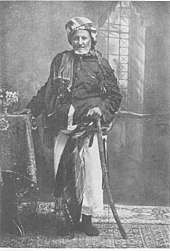Fadhli Sultanate
Fadhli (Arabic: فضلي Faḍlī), or the Fadhli Sultanate (Arabic: السلطنة الفضلية Salṭanat al-Faḍlī), was an independent sultanate on the southern coast of the Arabian Peninsula from at least the 15th century until 1967.[1]
| Fadhli Sultanate السلطنة الفضلية | |||||||
|---|---|---|---|---|---|---|---|
| State of the Federation of South Arabia | |||||||
| 15th century–1967 | |||||||
 Flag | |||||||
 Map of the Federation of South Arabia | |||||||
| Capital | Shuqrah, then Zinjibar | ||||||
| Area | |||||||
| • Coordinates | 13°25′N 45°40′E | ||||||
| • Type | Monarchy | ||||||
| History | |||||||
• Documented since | 15th century | ||||||
• Disestablished | 1967 | ||||||
| |||||||

History
The Fadhli Sultanate was one of the original "Nine Cantons" that signed protection agreements with Great Britain in the early 20th century and became part of the British Aden Protectorate.
It was a founding member of the Federation of Arab Emirates of the South in 1959 and its successor, the Federation of South Arabia, in 1963. The capital of the Fadhlis was Shuqrah, located on the coast of the Gulf of Aden, until 1962, when the administrative capital was moved to Zinjibar, located about 60 km to the east of Aden, although the sultan's residence remained at Shuqrah.
The last sultan, Nasser bin Abdullah bin Hussein bin Ahmed Alfadhli (السلطان ناصر بن عبدالله بن حسين بن أحمد الفضلي), was deposed and the state was abolished in 1967 upon the founding of the People's Republic of South Yemen, which is now part of the Republic of Yemen.
Sultans
The Sultanate extended back at least to Othman who ruled until 1670. The sultans were:[1][2]
- Othman (`Uthman), reigned ...–1670
- Fadhl I bin Othman, reigned 1670–1700
- Ahmed I bin Fadhl bin Othman, reigned 1700–1730
- Abdullah I bin Ahmed bin Fadhl, reigned 1730–1760
- Ahmed II bin Abdullah bin Ahmed, reigned 1760–1789
- Abdullah II, reigned 1789–1805
- Ahmed III bin Abdullah, reigned 1805–1819
- Abdullah III bin Ahmed bin Abdullah, reigned 1819–1828
- Haydara bin Ahmed bin Abdullah, reigned 1870–1877
- Hussein bin Ahmed bin Abdullah, reigned 1877 briefly
- Ahmed IV bin Hussein bin Ahmed, 1877–1907, signed treaty with British 1888[3]
- Hussein bin Ahmed bin Abdullah, second reign 1907–1924
- Abdul Qadir bin Ahmed bin Hussein, reigned 1924–1927
- Abdullah IV bin Hussein, reigned 1927–1929
- Fadhl II bin Hussein, reigned 1929–1933
- Abdul Karim, reigned 1933–1936
- Saleh bin Fadhl, reigned 1936–1941
- Abdullah V bin Othman (`Abd Allah ibn `Uthman), reigned 1941-1962, abdicated[4]
- Ahmed V bin Abdullah, reigned 1962–1964, abdicated[5]
- Nasser bin Abdullah bin Hussein bin Ahmed, reigned 1964–1967, the last sultan[6]
References
- "States of the Aden Protectorates: Fadli" World Statesmen
- Montgomery-Massingberd, Hugh (1980) "Fadhli Sultanate of Zingibar" Burke's Royal Families of the World: Africa & the Middle East (Volume 2 of Burke's royal families of the world) Burke's Peerage, London, page 3, ISBN 0-85011-023-8
- Hertslet's Commercial Treaties Volume 19 page 90
- Hinchcliffe, Peter; Ducker, John T. and Holt, Maria (2007) Without glory in Arabia: the British retreat from Aden Tauris, London, page 299, ISBN 978-1-84511-140-3
- Hinchcliffe, Peter; Ducker, John T. and Holt, Maria (2007) Without glory in Arabia: the British retreat from Aden Tauris, London, page 89, ISBN 978-1-84511-140-3
- Hinchcliffe, Peter; Ducker, John T. and Holt, Maria (2007) Without glory in Arabia: the British retreat from Aden Tauris, London, pages 89–91, 161, 168, ISBN 978-1-84511-140-3
Further reading
- Gavin, R.J. Aden Under British Rule, 1839-1967.